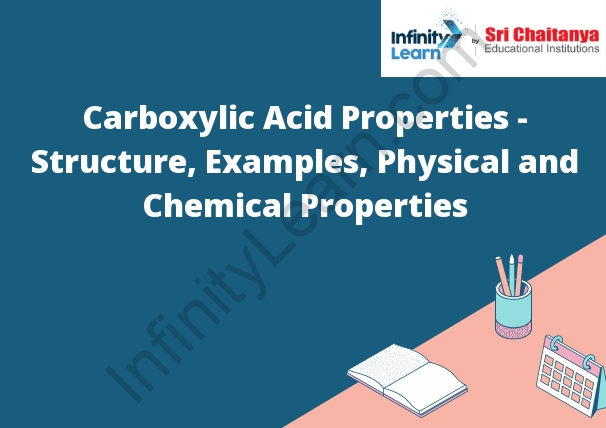Table of Contents
What is Carboxylic Acid?
A carboxylic acid is an organic compound that contains a carboxyl group (-COOH). Carboxylic acids are widely used in organic chemistry and biochemistry. They are important in the metabolism of proteins and lipids, and they play a role in the synthesis of complex molecules.

Carboxylic Acid Structure
A carboxylic acid has a carbon atom bonded to an oxygen atom that is also bonded to a hydrogen atom. This makes the carbon atom part of a carbon-oxygen (C=O) double bond. Attached to the carbon atom is a hydrogen atom and a hydroxyl group (-OH).
Nomenclature of Carboxylic Acids
The carboxylic acid functional group has the general formula -COOH. The name of a carboxylic acid begins with the prefix “carboxy-” followed by the stem of the alkane name with the “o” removed. For example, the carboxylic acid with the molecular formula C3H6O2 is called acetic acid.
Examples of Carboxylic Acid Derivatives
Carboxylic acid derivatives are organic molecules that contain a carboxylic acid functional group. This functional group is made up of a carbon atom double bonded to an oxygen atom and bonded to a hydroxyl group. The most common carboxylic acid derivatives are esters, amides, and anhydrides.
An ester is a molecule that contains a carboxylic acid group and an alcohol group. The carboxylic acid group and the alcohol group are attached to the same carbon atom. Amides are molecules that contain a carboxylic acid group and an amine group. The carboxylic acid group and the amine group are attached to the same carbon atom. Anhydrides are molecules that contain a carboxylic acid group and a ketone group. The carboxylic acid group and the ketone group are attached to the same carbon atom.
Examples of Carboxylic Functional Group
-CH 2 -COOH
-CH 2 -CH 2 -COOH
-CH 2 -CH 2 -CH 2 -COOH
Carboxylic Acid Properties
A carboxylic acid is a compound that has a carboxyl group (-COOH) attached to a hydrocarbon chain. Carboxylic acids are weak acids that are soluble in water. They are typically colorless and have a sour taste. Carboxylic acids are used in a variety of industrial and commercial applications, including the production of plastics, resins, and detergents.
Physical Properties of Carboxylic Acids and Esters
The table below summarizes the physical properties of carboxylic acids and esters.
Carboxylic Acid Ester Appearance Colorless, oily liquids Clear to slightly cloudy liquids Odor Acrid, pungent Pleasant, fragrant Boiling Point (°C) 80-100 85-115 Vapor Pressure (mmHg) Low Low Melting Point (°C) -5 to -15 -5 to -15 Solubility in Water Miscible Miscible
The boiling point of a carboxylic acid or ester is higher than that of the hydrocarbons from which they are derived. This is because the presence of the carboxyl group (C=O) increases the polarity of the molecule, making it more difficult to vaporize. The vapor pressure of a carboxylic acid or ester is also low, because the molecules are not very volatile.
The melting point of a carboxylic acid or ester is lower than that of the hydrocarbons from which they are derived. This is because the presence of the carboxyl group (C=O) decreases the polarity of the molecule, making it more difficult to crystallize.
Chemical Properties of Carboxylic Acids
The chemical properties of carboxylic acids depend on the functional group present in the molecule. For example, the chemical properties of acetic acid (CH3COOH) are very different from those of lactic acid (CH3CHOHCOOH).
The most important chemical property of carboxylic acids is their ability to form esters. Esters are molecules in which a carboxylic acid group is bonded to an alcohol group. The ester bond is very strong, and the reaction between a carboxylic acid and an alcohol is usually irreversible.
Uses of Carboxylic Acids
A carboxylic acid is an organic compound that contains a carboxyl group (COOH). This group consists of a carbon atom double-bonded to an oxygen atom and single-bonded to a hydroxyl group. Carboxylic acids are widely used in synthetic chemistry. Some of the most common applications are in the production of plastics, pharmaceuticals, and flavors and fragrances.
One of the most important applications of carboxylic acids is in the production of plastics. Carboxylic acids are used to make polyesters, which are used to make products such as water bottles, clothing, and car parts. Polyesters are strong, durable, and resistant to heat and chemicals.
Another common application of carboxylic acids is in the production of pharmaceuticals. Carboxylic acids are used to make drugs such as aspirin, ibuprofen, and acetaminophen. These drugs are effective and safe to use.
Carboxylic acids are also used to make flavors and fragrances. Carboxylic acids are used to make flavors such as vanilla, strawberry, and mint. Carboxylic acids are also used to make fragrances such as jasmine, rose, and lavender. These flavors and fragrances are safe to use and they smell good.
For more visit Uses of Carboxylic Acid | Structure and Properties of Carboxylic Acid







